PONTIAC VIBE 2010 Manual PDF
Manufacturer: PONTIAC, Model Year: 2010, Model line: VIBE, Model: PONTIAC VIBE 2010Pages: 318, PDF Size: 1.7 MB
Page 71 of 318

Replacing LATCH
System Parts After a
Crash
{CAUTION
A crash can damage the LATCH
system in the vehicle. A damaged
LATCH system may not properly
secure the child restraint, resulting
in serious injury or even death in
a crash. To help make sure the
LATCH system is working properly
after a crash, see your dealer/
retailer to have the system
inspected and any necessary
replacements made as soon
as possible.If the vehicle has the LATCH system
and it was being used during a crash,
new LATCH system parts may be
needed.
New parts and repairs may be
necessary even if the LATCH
system was not being used at
the time of the crash.
Securing Child Restraints
(Rear Seat Position)
When securing a child restraint
in a rear seating position, study the
instructions that came with the child
restraint to make sure it is compatible
with this vehicle.
If the child restraint has the LATCH
system, see
Lower Anchors and
Tethers for Children (LATCH System) on page 2-45
for how to
install the child restraint using
LATCH. If a child restraint is secured
in a seating position using a safety
belt and it uses a top tether, see
Lower Anchors and Tethers for
Children (LATCH System) on
page 2-45 for top tether anchor
locations.
Do not secure a child restraint in a
position without a top tether anchor if
a national or local law requires that
the top tether be anchored, or if the
instructions that come with the child
restraint say that the top strap must
be anchored.
In Canada, the law requires that
forward-facing child restraints have
a top tether, and that the tether
be attached.
Seats and Restraints 2-51
Page 72 of 318

If the child restraint does not have
the LATCH system, you will be using
the safety belt to secure the child
restraint in this position. Be sure to
follow the instructions that came
with the child restraint. Secure the
child in the child restraint when
and as the instructions say.
If more than one child restraint
needs to be installed in the
rear seat, be sure to readWhere
to Put the Restraint on page 2-43 .
1. Put the child restraint on the seat.
2. Pick up the latch plate, and run the lap and shoulder portions of
the vehicle’s safety belt through
or around the restraint. The child
restraint instructions will show
you how. 3. Push the latch plate into the
buckle until it clicks.
If the latch plate will not go fully
into the buckle, check if the
correct buckle is being used.
Position the release button
on the buckle so that the safety
belt could be quickly unbuckled
if necessary. 4. Pull the rest of the shoulder belt
all the way out of the retractor to
set the lock.
2-52 Seats and Restraints
Page 73 of 318
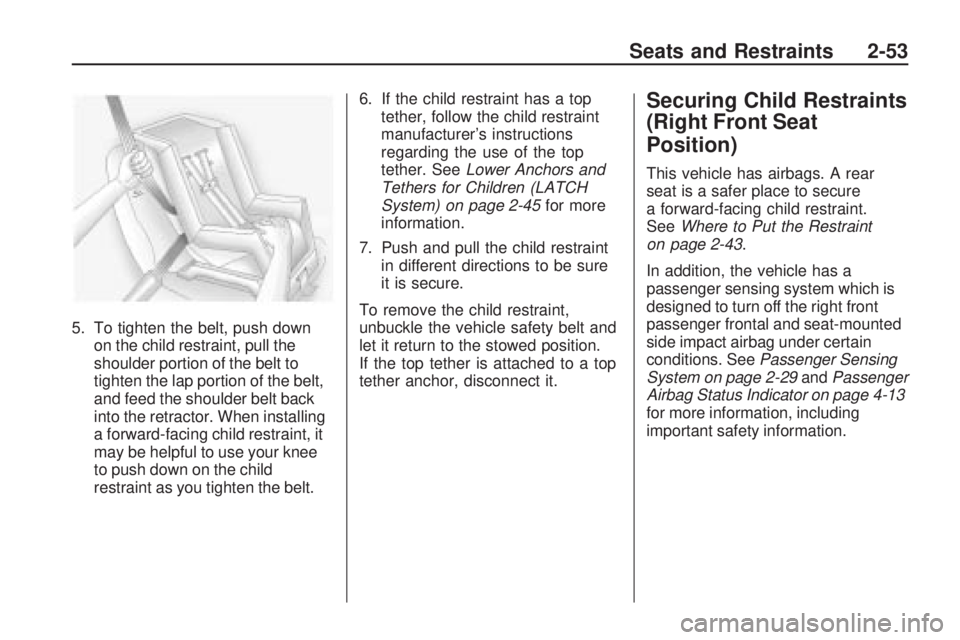
5. To tighten the belt, push downon the child restraint, pull the
shoulder portion of the belt to
tighten the lap portion of the belt,
and feed the shoulder belt back
into the retractor. When installing
a forward-facing child restraint, it
may be helpful to use your knee
to push down on the child
restraint as you tighten the belt. 6. If the child restraint has a top
tether, follow the child restraint
manufacturer’s instructions
regarding the use of the top
tether. See Lower Anchors and
Tethers for Children (LATCH
System) on page 2-45 for more
information.
7. Push and pull the child restraint in different directions to be sure
it is secure.
To remove the child restraint,
unbuckle the vehicle safety belt and
let it return to the stowed position.
If the top tether is attached to a top
tether anchor, disconnect it.
Securing Child Restraints
(Right Front Seat
Position)
This vehicle has airbags. A rear
seat is a safer place to secure
a forward-facing child restraint.
See Where to Put the Restraint
on page 2-43.
In addition, the vehicle has a
passenger sensing system which is
designed to turn off the right front
passenger frontal and seat-mounted
side impact airbag under certain
conditions. See Passenger Sensing
System on page 2-29 andPassenger
Airbag Status Indicator on page 4-13
for more information, including
important safety information.
Seats and Restraints 2-53
Page 74 of 318
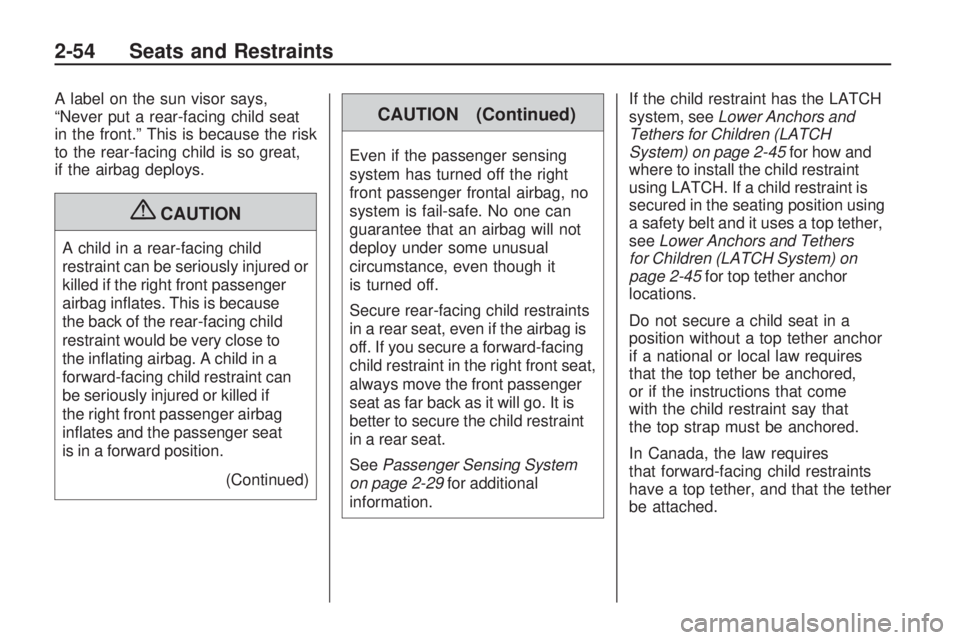
A label on the sun visor says,
“Never put a rear-facing child seat
in the front.” This is because the risk
to the rear-facing child is so great,
if the airbag deploys.
{CAUTION
A child in a rear-facing child
restraint can be seriously injured or
killed if the right front passenger
airbag inflates. This is because
the back of the rear-facing child
restraint would be very close to
the inflating airbag. A child in a
forward-facing child restraint can
be seriously injured or killed if
the right front passenger airbag
inflates and the passenger seat
is in a forward position.(Continued)
CAUTION (Continued)
Even if the passenger sensing
system has turned off the right
front passenger frontal airbag, no
system is fail-safe. No one can
guarantee that an airbag will not
deploy under some unusual
circumstance, even though it
is turned off.
Secure rear-facing child restraints
in a rear seat, even if the airbag is
off. If you secure a forward-facing
child restraint in the right front seat,
always move the front passenger
seat as far back as it will go. It is
better to secure the child restraint
in a rear seat.
SeePassenger Sensing System
on page 2-29 for additional
information. If the child restraint has the LATCH
system, see
Lower Anchors and
Tethers for Children (LATCH
System) on page 2-45 for how and
where to install the child restraint
using LATCH. If a child restraint is
secured in the seating position using
a safety belt and it uses a top tether,
see Lower Anchors and Tethers
for Children (LATCH System) on
page 2-45 for top tether anchor
locations.
Do not secure a child seat in a
position without a top tether anchor
if a national or local law requires
that the top tether be anchored,
or if the instructions that come
with the child restraint say that
the top strap must be anchored.
In Canada, the law requires
that forward-facing child restraints
have a top tether, and that the tether
be attached.
2-54 Seats and Restraints
Page 75 of 318
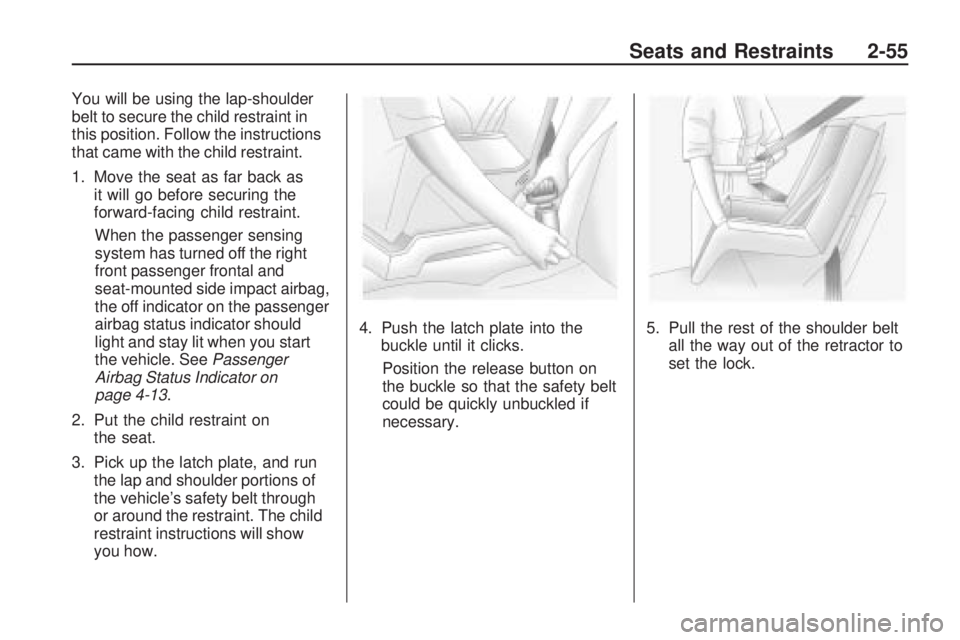
You will be using the lap-shoulder
belt to secure the child restraint in
this position. Follow the instructions
that came with the child restraint.
1. Move the seat as far back asit will go before securing the
forward-facing child restraint.
When the passenger sensing
system has turned off the right
front passenger frontal and
seat-mounted side impact airbag,
the off indicator on the passenger
airbag status indicator should
light and stay lit when you start
the vehicle. See Passenger
Airbag Status Indicator on
page 4-13.
2. Put the child restraint on the seat.
3. Pick up the latch plate, and run the lap and shoulder portions of
the vehicle’s safety belt through
or around the restraint. The child
restraint instructions will show
you how. 4. Push the latch plate into the
buckle until it clicks.
Position the release button on
the buckle so that the safety belt
could be quickly unbuckled if
necessary. 5. Pull the rest of the shoulder belt
all the way out of the retractor to
set the lock.
Seats and Restraints 2-55
Page 76 of 318
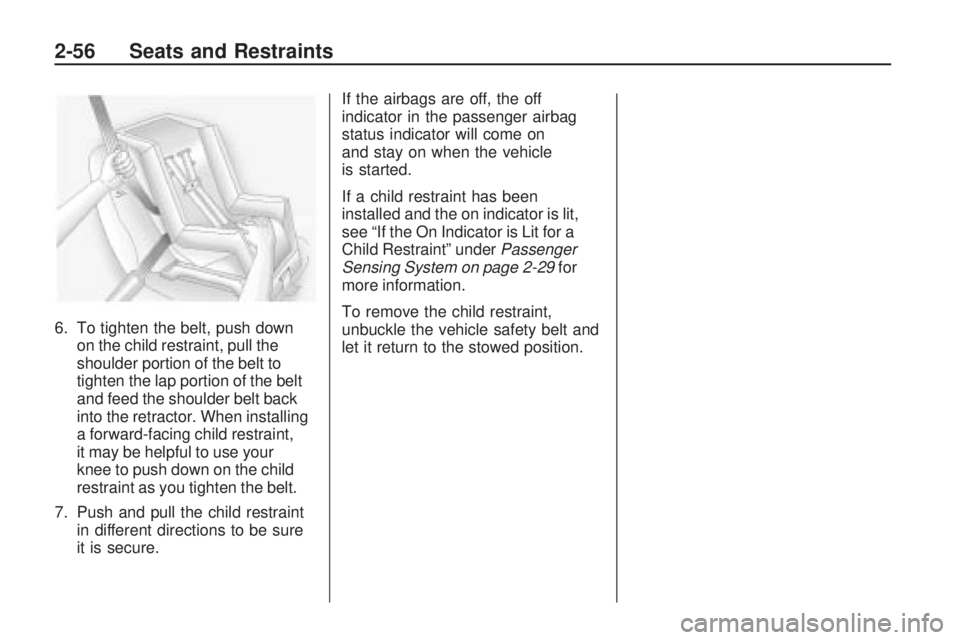
6. To tighten the belt, push downon the child restraint, pull the
shoulder portion of the belt to
tighten the lap portion of the belt
and feed the shoulder belt back
into the retractor. When installing
a forward-facing child restraint,
it may be helpful to use your
knee to push down on the child
restraint as you tighten the belt.
7. Push and pull the child restraint in different directions to be sure
it is secure. If the airbags are off, the off
indicator in the passenger airbag
status indicator will come on
and stay on when the vehicle
is started.
If a child restraint has been
installed and the on indicator is lit,
see “If the On Indicator is Lit for a
Child Restraint” under
Passenger
Sensing System on page 2-29 for
more information.
To remove the child restraint,
unbuckle the vehicle safety belt and
let it return to the stowed position.
2-56 Seats and Restraints
Page 77 of 318
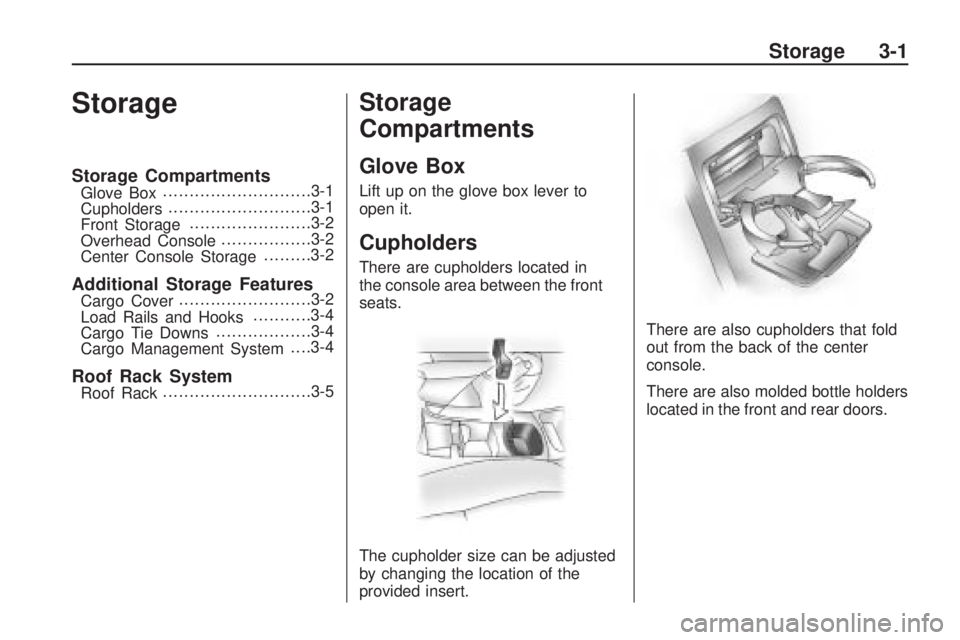
Storage
Storage CompartmentsGlove Box...........................
.3-1
Cupholders ..........................
.3-1
Front Storage ......................
.3-2
Overhead Console ................
.3-2
Center Console Storage .........3-2
Additional Storage FeaturesCargo Cover........................
.3-2
Load Rails and Hooks ...........3-4
Cargo Tie Downs .................
.3-4
Cargo Management System . . . .3-4
Roof Rack SystemRoof Rack...........................
.3-5
Storage
Compartments
Glove Box
Lift up on the glove box lever to
open it.
Cupholders
There are cupholders located in
the console area between the front
seats.
The cupholder size can be adjusted
by changing the location of the
provided insert. There are also cupholders that fold
out from the back of the center
console.
There are also molded bottle holders
located in the front and rear doors.
Storage 3-1
Page 78 of 318
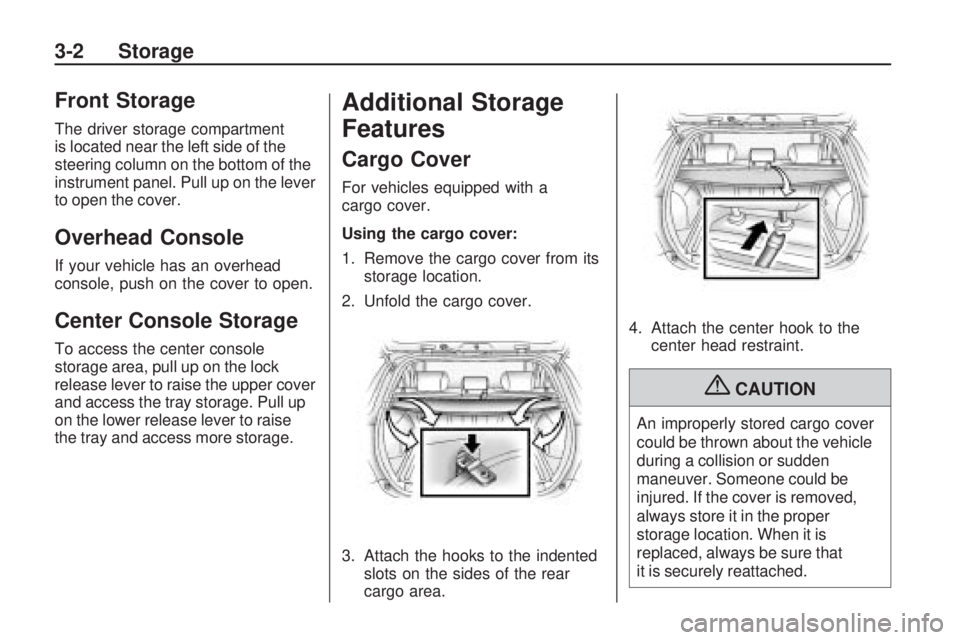
Front Storage
The driver storage compartment
is located near the left side of the
steering column on the bottom of the
instrument panel. Pull up on the lever
to open the cover.
Overhead Console
If your vehicle has an overhead
console, push on the cover to open.
Center Console Storage
To access the center console
storage area, pull up on the lock
release lever to raise the upper cover
and access the tray storage. Pull up
on the lower release lever to raise
the tray and access more storage.
Additional Storage
Features
Cargo Cover
For vehicles equipped with a
cargo cover.
Using the cargo cover:
1. Remove the cargo cover from itsstorage location.
2. Unfold the cargo cover.
3. Attach the hooks to the indented slots on the sides of the rear
cargo area. 4. Attach the center hook to the
center head restraint.
{CAUTION
An improperly stored cargo cover
could be thrown about the vehicle
during a collision or sudden
maneuver. Someone could be
injured. If the cover is removed,
always store it in the proper
storage location. When it is
replaced, always be sure that
it is securely reattached.
3-2 Storage
Page 79 of 318
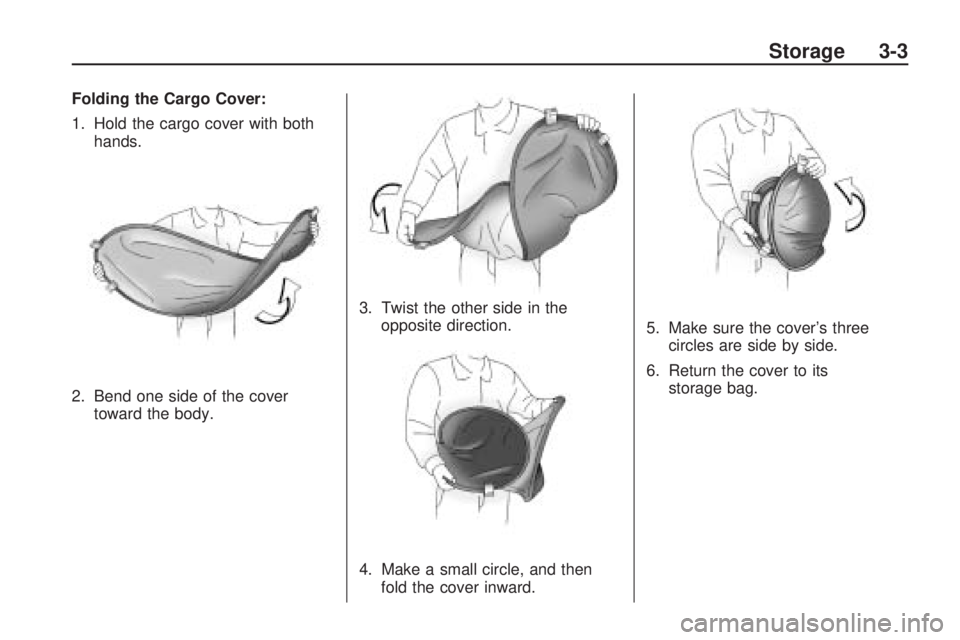
Folding the Cargo Cover:
1. Hold the cargo cover with bothhands.
2. Bend one side of the cover toward the body. 3. Twist the other side in the
opposite direction.
4. Make a small circle, and then fold the cover inward. 5. Make sure the cover’s three
circles are side by side.
6. Return the cover to its storage bag.
Storage 3-3
Page 80 of 318
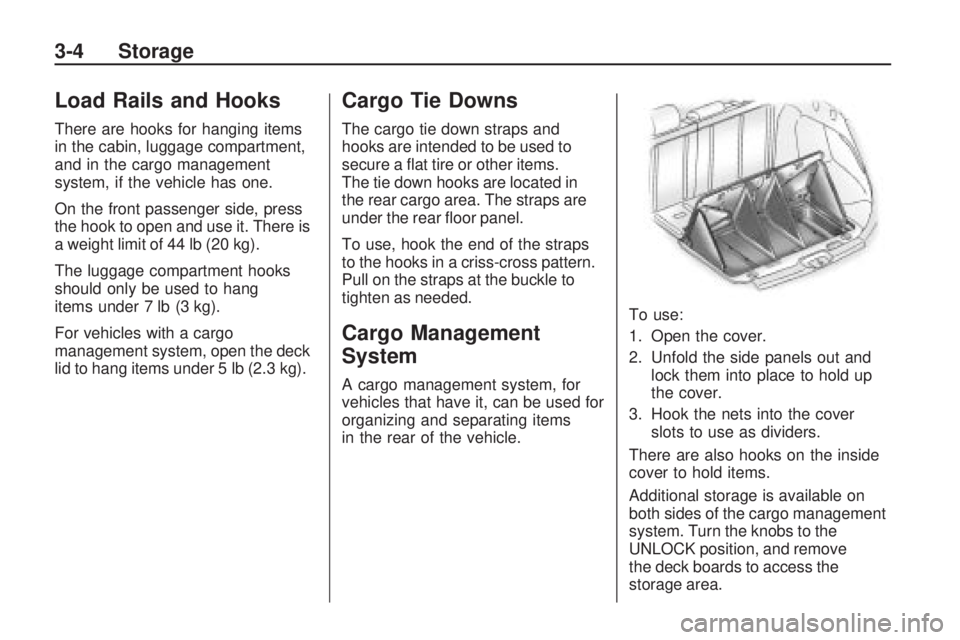
Load Rails and Hooks
There are hooks for hanging items
in the cabin, luggage compartment,
and in the cargo management
system, if the vehicle has one.
On the front passenger side, press
the hook to open and use it. There is
a weight limit of 44 lb (20 kg).
The luggage compartment hooks
should only be used to hang
items under 7 lb (3 kg).
For vehicles with a cargo
management system, open the deck
lid to hang items under 5 lb (2.3 kg).
Cargo Tie Downs
The cargo tie down straps and
hooks are intended to be used to
secure a flat tire or other items.
The tie down hooks are located in
the rear cargo area. The straps are
under the rear floor panel.
To use, hook the end of the straps
to the hooks in a criss-cross pattern.
Pull on the straps at the buckle to
tighten as needed.
Cargo Management
System
A cargo management system, for
vehicles that have it, can be used for
organizing and separating items
in the rear of the vehicle.To use:
1. Open the cover.
2. Unfold the side panels out and
lock them into place to hold up
the cover.
3. Hook the nets into the cover slots to use as dividers.
There are also hooks on the inside
cover to hold items.
Additional storage is available on
both sides of the cargo management
system. Turn the knobs to the
UNLOCK position, and remove
the deck boards to access the
storage area.
3-4 Storage